| home | stands | games | about | mpjournal | back | links |
In a right-angled triangle, the size of any angle is related to the ratio of
the lengths of any two sides by the trigonometric functions. The basic functions
are sine, cosine, and tangent. These functions are based on the similarity of
triangles that have a right angle and one other angle in common. Imagine an
angle A formed by the intersection of lines AB and AC (see diagrams). A third
line drawn perpendicularly up from AC gives a right-angled triangle. The sides
of such a triangle will always be in the same ratio to one another, no matter
where the third line intersects AC.
Sine
The sine of angle A is the ratio of the lengths BC to AB.
Cosine
The cosine of angle A is the ratio of the lengths AC to AB.
Tangent
The tangent of angle A is the ratio of the lengths BC to AC.
Relationships between the lengths of the sides and the sizes of the angles of any triangle are given by the cosine and sine rules. Provided we have enough information already, we can use the cosine and sine rules to find the length of a side, or the size of an angle. We usually use these methods only for triangles that do not have a right angle because easier methods for finding the dimensions of right-angled triangles exist.
The cosine rule states that, for the triangle ABC in Diagram 1,
a2 = b2 + c2 - 2bccosA

Diagram 1
We can use the cosine rule to calculate the length of the third side of a triangle if we know the lengths of the other two sides and the size of the angle between them (the included angle). For example, suppose we want to find the length of side a in the triangle in Diagram 2.

Diagram 2
We know that length b = 6, length c = 8, and angle A = 120°. Therefore, we can use the cosine rule, as follows:
a2 = b2 + c2 - 2bccosA
= 62 + 82 - 2 × 6 × 8 × cos120°
= 36 + 64 - 96 × -0.5
= 148
Therefore,
a = Ö148
= 12.166 (to 3 decimal places)
We can also use the cosine rule to find the size of any angle of a triangle if
we know the lengths of all three sides. For example, suppose we want to find the
size of angle A in the triangle in Diagram 3.
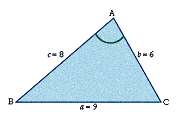
Diagram 3
We know that length a = 9, length b = 6, and length c = 8. Therefore, we can
use the cosine rule to find angle A, as follows:
a2 = b2 + c2 - 2bccosA
Rearranging this formula gives us
cosA=(b2+c2 - a2) / 2bc
So,
cosA=(62+82 - 92) / 2x6x8
=(36+64 - 81) / 96
=19/96 = 0.19792...
Therefore,
A = cos-10.19792 = 78.585° (to 3 decimal places)
The sine rule states that, for the triangle ABC shown in Diagram 4,
![]()
where R is the radius of the circumcircle (the circle that passes through A, B, and C, and is said to circumscribe the triangle ABC).
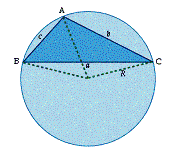
Diagram 4
The sine rule can be used to obtain information about a triangle if we know the length of one side and the sizes of two angles. To use the sine rule in this way, we need to know the size of the angle that is opposite the side whose length we know; thus in the triangle in Diagram 5 we need to know the size of angle A since it is opposite the side whose length is known, a.

Diagram 5
However, if we do not have the size of this angle, we can easily calculate it
since we know the sizes of the other two angles. The sum of the interior angles
of a triangle is always 180°, so the size of angle A in Diagram 5 is given by
180° - (B + C) = 180° - (40° + 20°)
= 180° - 60° = 120°
Suppose we want to find the length of side b in the triangle in Diagram 5. We know that the length of side a = 12, that angle A = 120°, and angle B = 40° and, therefore, we can use the sine rule, as follows:
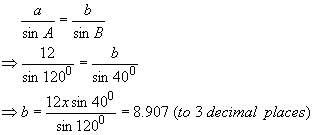
We could find the length of side c in a similar way.
The sine rule can also be used to obtain information about a triangle if we
know the lengths of two sides and the size of a nonincluded angle (that is, one
of the angles that is not between the two sides whose lengths we know). If we
know the lengths of two sides and the size of the included angle, we would use
the cosine rule, as explained earlier.
Suppose we want to find the size of angle C in the triangle in Diagram 6.

Diagram 6
We know that the length of side a = 10, and of side c = 4, and that angle A = 130°, and so we can use the sine rule, as follows:
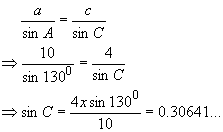
Therefore,
C = sin-10.30641 = 17.843° (to 3 decimal places)
We could find the size of the third angle, B, very easily by subtracting the sum
of angles A and C from 180°, as we did earlier.
Suppose we have the two triangles in Diagram 7.

Diagram 7
In both triangles the angle B = 40°, the length of side b = 8, and the length of side c = 10. Suppose we want to find the size of angle C. Using the sine rule gives us
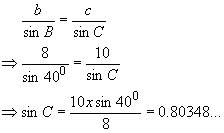
Therefore,
C = sin-10.80348 = 53.464° (to 3 decimal places)
This gives the size of angle C for the left-hand triangle, but angle C in the
right-hand triangle is clearly greater than 90°. This is because there is also
an angle between 90° and 180° for which sinC = 0.80348…. We can find this
angle by taking the acute angle (53.464°) away from 180°. Thus the size of
angle C in the right-hand triangle is given by
180° - 53.4641° = 126.536° (to 3 decimal places)
This is called the ambiguous case since it is possible to draw two different
triangles that both satisfy the original information.
This table gives the sines, cosines, and tangents of some commonly encountered angles.
